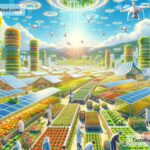The Future of Food: How Regenerative Innovation Can Help Us Eat Sustainably
Food is one thing we all need to survive, yet the way we produce and consume food today is causing problems for our planet. Climate change, deforestation, pollution, and loss of biodiversity are closely connected to our food systems. But there’s good news. Scientists, farmers, and innovators are working together to change how we grow, produce, and distribute food to make it sustainable—and not just sustainable, but regenerative. Let’s explore what this means and how the future of food could be brighter for everyone.
What’s Wrong with the Current Food System?
The way we produce food has become more industrialized over the last 100 years. Big machines, chemical fertilizers, and pesticides have helped us grow more food to feed a growing population. While this sounds great, it also has some major downsides:
- Soil Damage: Intensive farming strips the soil of nutrients, making it harder to grow crops in the future.
- Climate Impact: Agriculture is responsible for up to 30% of global greenhouse gas emissions.
- Water Waste: Farms use massive amounts of water, sometimes drying up rivers and reservoirs.
- Biodiversity Loss: Clearing forests and using pesticides harms wildlife, including bees that help pollinate crops.
- Food Waste: A third of all food produced globally is wasted. This adds pressure on land, water, and energy resources.
If we don’t change how food is produced, climate change and environmental degradation will get worse—and in the future, there won’t be enough healthy food for everyone.
Regenerative Innovation: A New Approach to Food Systems
So, what’s the solution? Experts suggest moving beyond sustainability toward regenerative practices. Simply put, regenerative systems don’t just minimize harm—they actually restore and improve the environment. Imagine growing food while helping the soil get healthier, storing carbon in the ground, and boosting biodiversity. It’s about giving back to the planet, not just taking from it.
Regenerative innovation combines nature-driven techniques (like composting or crop rotation) with cutting-edge technology (such as AI, drones, and vertical farming). Together, these approaches can transform the entire food system—from farming to food delivery to how we compost leftovers.
Key Innovations Shaping the Future of Food
Here are some exciting ideas and technologies leading the revolution in food and agriculture:
1. Regenerative Farming
Traditional farming methods often focus on maximizing output—growing as much as possible, as quickly as possible. Regenerative farming looks at things differently. It uses practices like planting cover crops, reducing chemicals, and rotating crops to heal the soil and protect water resources. Healthy soil traps carbon dioxide from the air, which can reduce climate change while increasing the amount of food we grow.
2. Urban Agriculture
As cities grow bigger, farmland often disappears. But people are finding creative ways to grow food in cities on rooftops, vertical farms, and indoor hydroponic systems. These methods save space, use less water, and don’t require toxic pesticides. Plus, it keeps food closer to where people live, cutting down travel emissions.
3. Lab-Grown Protein
Animals like cows and chickens require tons of land, food, and water, and they emit methane—a potent greenhouse gas. A solution? Lab-grown meat! Scientists now grow meat (and even fish and dairy) in labs using cells, rather than raising animals. This process eliminates the need for factory farms and uses far fewer resources.
4. AI and Data-Driven Farming
Artificial intelligence (AI) and machine learning are helping farmers grow food more efficiently. Drones can monitor crops, detect pests, and measure soil health. Apps can share data to help farmers make better decisions about planting and harvesting, reducing waste.
5. Circular Food Systems
Our current food system is linear: Food is grown, eaten, and wasted. But what if food waste could be turned into something useful? Circular systems aim to reuse waste, like converting leftover food into compost or energy. For example, some companies use food scraps to grow mushrooms or create biofuels.
Why Regenerative Innovation Matters for Everyone
Regenerative food systems benefit more than just the environment; they help people, too. Farmers can earn better incomes by restoring their land’s health, and communities can access more nutritious, locally grown food. Using fewer chemicals also means safer food and cleaner water for everyone.
Importantly, regenerative innovation is about justice. Poor and marginalized communities often suffer the most from unhealthy food systems, with less access to affordable, fresh food and clean resources. Redesigning food systems offers an opportunity to create fairer and healthier societies.
What Can You Do?
It’s easy to feel overwhelmed by big issues like climate change or food waste, but everyone can play a part in shaping the future of food. Here are some simple actions you can take:
- Eat More Plants: Plant-based diets are better for the planet because they use fewer resources than meat-based diets.
- Support Local Farmers: Buy fruits, vegetables, and meats grown nearby to reduce transportation emissions.
- Cut Food Waste: Plan meals, store food properly, and compost what you can.
- Learn and Share: Educate yourself about regenerative practices and share what you learn with friends and family.
Looking Ahead
The future of food doesn’t have to be scary. With regenerative innovation, we can grow food in ways that heal the planet instead of hurting it. It’s a challenging journey, but the rewards—clean air, healthy ecosystems, better nutrition, and fairer economies—are worth it. By working together and using human creativity, technology, and nature-inspired solutions, we can ensure that future generations have enough food to thrive.
Let’s imagine a world where every bite of food contributes to a healthier earth. Exciting, isn’t it? The future of food is regenerative, innovative, and full of possibilities. Let’s make it happen.

